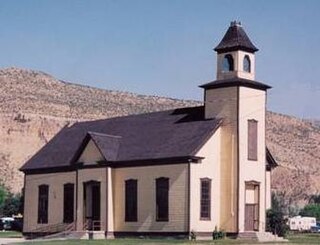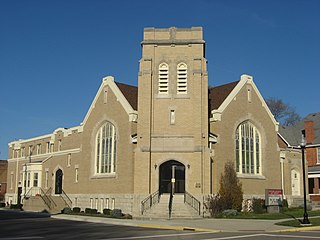Burlington is a census-designated place (CDP) in Mineral County, West Virginia, United States, located along U.S. Route 50 where it crosses Pattersons Creek. As of the 2020 census, its population was 131. It is part of the Cumberland, MD-WV Metropolitan Statistical Area. The ZIP code for Burlington is 26710.

Piney Grove at Southall's Plantation is a property listed on the National Register of Historic Places in Holdcroft, Charles City County, Virginia. The scale and character of the collection of domestic architecture at this site recalls the vernacular architectural traditions of the eighteenth, nineteenth and twentieth centuries along the James River.

The Mission Church is a historic Congregational church located at the corner of Huron and Tuscott Streets on Mackinac Island, Michigan, United States. Built in 1829, it was the oldest surviving church in the state of Michigan. In 1971, the Mission Church was listed on the National Register of Historic Places.

The Old Indian Meeting House is a historic meeting house at 410 Meetinghouse Road in Mashpee, Massachusetts. Built in 1758, the meetinghouse is the oldest Native American church in the eastern United States and the oldest church on Cape Cod. The building was listed on the National Register of Historic Places in 1998.

The Old Faithful Historic District in Yellowstone National Park comprises the built-up portion of the Upper Geyser Basin surrounding the Old Faithful Inn and Old Faithful Geyser. It includes the Old Faithful Inn, designed by Robert Reamer and is itself a National Historic Landmark, the upper and lower Hamilton's Stores, the Old Faithful Lodge, designed by Gilbert Stanley Underwood, the Old Faithful Snow Lodge, and a variety of supporting buildings. The Old Faithful Historic District itself lies on the 140-mile Grand Loop Road Historic District.

Buffalo Presbyterian Church is a historic Presbyterian Church located in Pamplin, Prince Edward County, Virginia. Built about 1804, it is a simple frame weather-boarded structure with a gable roof covered with standing seam metal. Early in the 20th century the front of the church was reoriented to the east and, in 1931, an addition was made, consisting of an entrance vestibule flanked on either side by a small classroom. Also on the property is the contributing church cemetery, with a number of stone markers, the earliest of which is dated 1832. The congregation of Buffalo was formed in 1739 and is the earliest extant Presbyterian congregation in Southside Virginia.

The Waiākea Mission Station was the first Christian mission on the eastern side of the Island of Hawaiʻi. Also known as the Hilo Station, the latest structure is now called Haili Church.

The Emery LDS Church is significant as the oldest remaining religious building in Emery County and as the last remaining “New England” clapboard style meetinghouse of the Church of Jesus Christ of Latter-day Saints in Utah. Structurally, the meetinghouse is significant because of its wood-frame construction sheathed in clapboard and lined with non-load bearing wall of adobe. This construction technique was very unusual for a Mormon meetinghouse built at the turn of the 20th century.

The Allenstown Meeting House is a historic meeting house on Deerfield Road in Allenstown, New Hampshire. Built in 1815, it is New Hampshire's only surviving Federal-style single-story meeting house to serve both religious and civic functions. It was listed on the National Register of Historic Places in December 2004, and the New Hampshire State Register of Historic Places in July 2004. It is presently owned and maintained by the town.

The Vardy Community School was a Presbyterian mission school established in the Vardy community of Hancock County, Tennessee, United States, in the late-19th and early-20th centuries. At the time of its founding, the school was the only institution providing primary education to children of the multi-racial Melungeon communities, who lived in the remote mountainous areas along the Tennessee-Virginia border.

First United Methodist Church is a historic church at 129 W. Hutchison in San Marcos, Texas.

The Atascosa County Courthouse is a historic courthouse built in 1912 on Circle Dr in Jourdanton, Texas. The Mission Revival Style architecture building was designed by San Antonio architect Henry T. Phelps. The building contract was awarded to the Gordon Jones Construction Co. of San Antonio, based on a bid of $65,000. It was added to the National Register of Historic Places on December 30, 1997. Atascosa County was formed in 1856. The first Atascosa County Courthouse was a log building erected in Amphion in 1856. The second a frame building raised in Pleasanton in 1857. The county built a larger frame courthouse in 1868. The fourth courthouse, built in 1885 was made from red stone and served as the Pleasanton City Hall when the county seat was moved to Jourdanton.

The Pleasant Hill United Church of Christ is a historic church in the village of Pleasant Hill in the western part of the U.S. state of Ohio. Built in the early twentieth century, it was the fourth building used as the home of one of the area's oldest congregations, and it has been named a historic site.

Church of Sts. Peter and Paul—Catholic is a historic church building on State Street in Gilman, Minnesota, United States. It was built in 1930 to serve a Polish-American congregation and designed in the Beaux Arts style by the Minneapolis architectural firm of Cordell & Olson. The first church was a log structure in 1872. It was known as the church of St. Wenceslas. Then a new church was built in the 1880s and was a frame structure known as St. Casimir's Church. The old log church was converted into classrooms. A new school building was built in 1909 and is present today. St. Casimir's church was destroyed by fire in 1891. A new and larger frame building was constructed for the new church. This church building stood north of the present brick building. The school building was completed in 1909. Fr. Vincent Wotzka as pastor had a brick rectory built in 1924. It was also designed by Cordelia and Olson. Sometime during these early years, the name of the parish was changed to Saints Peter and Paul. No reason has been found for the change. The church complex was added to the National Register of Historic Places in 1982.

The Russian Bishop's House, once the Russian Mission Orphanage, is a historic house museum and National Historic Landmark at Lincoln and Monastery Streets in Sitka, Alaska. Built in 1841–43, this log structure is one of the oldest surviving buildings of Russian America, and was one of the centerpieces of the Russian Orthodox church's efforts to spread its influence among the natives of Alaska. It was the home and administrative center of Ivan Veniaminov, the first Bishop of Alaska, later canonized as Innocent of Alaska. The house is now a unit of Sitka National Historical Park, and is administered by the National Park Service.

Old Pine Church, also historically known as Mill Church, Nicholas Church, and Pine Church, is a mid-19th century church located near to Purgitsville, West Virginia, United States. It is among the earliest extant log churches in Hampshire County, along with Capon Chapel and Mount Bethel Church.

The East Andover Village Center Historic District encompasses the historic village center of East Andover, New Hampshire, United States. The 2.2-acre (0.89 ha) district includes a cemetery and three buildings: the Andover Congregational Church, the Highland Lake Grange Hall, and the East Andover Schoolhouse. It is located at the corner of New Hampshire Route 11 and Chase Hill Road. The district is unified by the appearance of the three buildings, and their styling, which is predominantly vernacular 19th century.

Son's Chapel is a historic church at 5480 East Mission in Fayetteville, Arkansas. It is a single-story rustic fieldstone structure, with front-gable roof and a squat square tower set off to one side. Built between 1933 and 1937, the building is an interesting and unusual mix of Gothic and Romanesque styles, with windows set under Romanesque arches, and the tower with a crenellated parapet. The church is the second for the congregation, which was established c. 1848 on land donated by Michael Son.
The Alpine Elementary School is a compound consisting of four buildings in Alpine, Arizona, operated by the public Alpine Elementary School District. It serves grades K-8. The original school building of this complex was built in 1930, but a government-funded school had operated here since 1882. The current gym/auditorium was constructed in 1939 for use as a chapel of the Church of Jesus Christ of Latter-day Saints, which had members in the community.






















